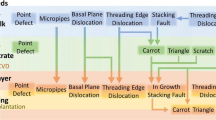Abstract
Recently, the suppression of boron diffusion due to both thermal and transient enhanced diffusion (TED) has been demonstrated through the incorporation of 0.5% substitutional carbon in the base of Si/SiGe/Si heterojunction transistor’s (HBT)[1,2]. Because the devices are sensitive to diffusion on a scale less than that we can detect with SIMS, in this paper combined process and device modeling (TMA TSUPREM4 and MEDICI) are used to relate observed electrical characteristics (collector saturation currents and Early voltages) of the HBT’s to boron diffusion, with a sensitivity of 20-30Å. Boron diffusivity in the SiGeC base is ~8 times slower than that of the boron diffusivity in the SiGe base without implant damage (no TED). In the case of ion implant damage in an overlying layer to cause TED the excess interstitial concentration due to ion implant damage is reduced by approximately 99% through incorporation of 0.5% substitutional carbon in the HBT SiGe bases. This demonstrates that carbon incorporation acts as an effective sink for interstitials.
Similar content being viewed by others
References
L. D. Lanzerotti, J. C. Sturm, E. Stach, R. Hull, T. Buyuklimanli, and C. Magee, IEDM Tech. Dig. 249 (1996)
L. D. Lanzerotti, J. C. Sturm, E. Stach, R. Hull, T. Buyuklimanli, and C. Magee, APL, 70(23), 9 June 1997
A. Schuppen, U. Urben, A Gruhle, H. Kibbel, H. Schumacher, and U. Konig, IEDM Tech. Dig. 743 (1995)
E. J. Prinz, P. M. Garone, P. V. Schwartz, X. Xiao, and J.C. Sturm, IEEE Electron Device Letters, 12, 42 (1991)
P.A. Stolk, H. J. Gossman, D. J. Eaglesham, J. M. Poate, Mat. Sci. & Eng. B36 (1996) 275–281
R. Scholz, U. Gdsele, J. Y. Huh, T. Y. Tan, APL, 72 (2), 12 Jan 1998
H. J. Osten, G. Lippert, P. Gaworzewski, R. Sorge, APL 71 (11), 15 Sep 1997
E. J. Prinz, J. C. Sturm, Tech. Digest IEDM 853 (1991)
J. C. Sturm, P. V. Schwartz, E. J. Prinz, H. Manoharan, J. Vac. Sci. Tech B 9 2011 (1991)
Z. Matutinovic-Krstelj, V. Venkataraman, E.J. Prinz, J.C. Sturm, IEEE Transactions on Electron Devices, vol 43, No 3, March 1996.
R. B. Fair, Impurity Doping Processes in Silicon, North Holland, 1981, edited by F. F. Y. Wang.
H. Rückert, B. Heinemann, W. Röpke, G. Fischer, G. Lippert, H.J. Osten, R. P. Krups, Proceedings of the International Conference on Simulation of Semiconductor Precesses and Devices (Cambridge 1997)
P. Kuo, J. L. Hoyt, Gibbons, Turner, Jacowitz, Kamins, APL, 62 (6), 8 Feb. 1993
Author information
Authors and Affiliations
Rights and permissions
About this article
Cite this article
Carroll, M.S., Lanzerotti, L.D. & Sturm, J.C. Quantitative Measurement of Reduction of Boron Diffusion by Substitutional Carbon Incorporation. MRS Online Proceedings Library 527, 417–422 (1998). https://doi.org/10.1557/PROC-527-417
Published:
Issue Date:
DOI: https://doi.org/10.1557/PROC-527-417




